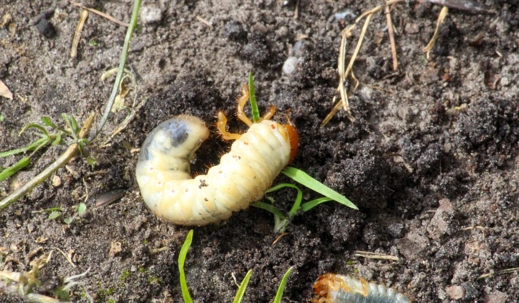When to Treat for Grubs in Florida
Grubs: those sneaky underground munchers can turn your lush Florida lawn into a patchy mess. But don’t worry.
Knowing when to battle these pests is half the victory. The best time? From late summer to early fall, when they’re young and vulnerable.
Ready to take back your turf? Keep reading the grub lifecycle and snag those pests at the perfect moment!
Key Takeaways
- The optimal time to treat grubs in Florida is from late summer to early fall, targeting their most vulnerable stage to prevent lawn damage.
- Signs of a grub infestation include irregular brown patches on the lawn, increased bird and wildlife activity, and areas where the turf feels spongy or lifts quickly.
- Starting preventive treatments in late spring with specific insecticides disrupts the grub lifecycle before they mature and damage the lawn.
- If grub damage is significant or home remedies are ineffective, it's advisable to call professional lawn care services to manage and eradicate the infestation efficiently.
When Is the Best Time to Treat for Grubs
.2406300013028.webp)
Effective grub treatment requires timing treatments with their lifecycle and activity in Florida. Hence, taking action at the right time can prevent damage to your lawn.
Best Months for Grub Treatment
In Florida, grub treatment should begin in late summer to early fall. This timing is critical as it targets the grubs when they are most vulnerable and before they cause significant damage.
Here’s a timeline on when you should treat grub damage:
Month | Details |
June | Preventative treatments can start against early species. |
July | Target newly hatched larvae from early beetles. |
August | The most effective time to treat, as larvae are young and actively feeding. |
September | Late treatments can still be effective, especially in South Florida. |
October | The last chance for treatment before grubs mature to reduce the next season's population. |
Peak Grub Activity Periods
To detect when white grubs feast on grass roots in your Florida lawn, look for signs of damage or activity. Grubs are often most active during warm temperatures when the soil is moist.
Here’s a closer look at the best observation times and what you can expect:
Best Observation Time | Signs to Expect | Treatment Action |
Late summer to fall | Irregular brown or dead patches | Apply insecticides like GrubEx or Scotts. |
Late summer to fall | Increased bird or animal activity | Inspect lawn for grubs and consider application. |
Late summer | Turf that lifts quickly or feels spongy | Confirm the presence, and treat them as necessary. |
What Are the Signs of Grub Infestation
Detecting a grub infestation early is crucial to maintaining a healthy lawn. In addition to unmistakable lawn damage, another critical indicator includes unusual wildlife behavior.
Increased Bird or Wildlife Activity
Animals like raccoons and skunks are grub connoisseurs. Their sudden interest in a lawn hints at a grub problem. Keep an eye out for:
- Frequent bird gatherings: Birds pecking constantly at the lawn, mainly if localized.
- Nighttime visitors: Skunks or raccoons may dig up the lawn searching for grubs.
- Unusual diggings: Small holes or torn-up grass could indicate animals snacking on grubs.
How to Time Preventive Grub Control
Timing preventive and effective grub control is critical for maintaining a healthy lawn in Florida.
Seasonal Treatment Strategies
In Florida, timing the application of pesticides can significantly increase the efficacy of grub prevention. Here’s what you can use during changing seasons:
Month | Product Example | Benefit |
May - June | Imidacloprid | Targets larvae before they mature and damage the lawn. |
July | Acelepryn | Continues protection during peak grub activity. |
August | Curative Insecticides | Addresses any active grubs to prevent further damage. |
Year-Round Lawn Care Practices
To keep grub populations in check, you must ensure a nurturing environment for turfgrass. Here's how to maintain robust lawn health to prevent mature grub worms from coming back:
Regular Soil Testing: Test the soil to assess nutrient levels and pH balance—this can optimize turf strength and deter grubs.
Deep, Infrequent Watering: Water your lawn deeply but infrequently, encouraging strong root systems.
Aeration: Aerate the soil at least once a year to improve drainage and reduce thatch buildup.
Organic Matter Application: Apply organic matter, such as compost, to enrich soil and promote beneficial microorganisms.
Proper Fertilization: Use a spreader to evenly distribute fertilizers and soil conditioners evenly, avoiding over-fertilization that damages root systems.
Pest Control and Monitoring: Regularly conduct measures to keep other pests away from every square foot of your lawn.
Should You Call the Lawn Experts?
When grubs decide to make a meal out of your lush St. Augustine lawn, it can leave you scratching your head and googling DIY remedies. But sometimes, passionate lawn defenders like you need to know when to tag in the professionals.
The decision to call in the experts shouldn't be a tough one. When your lawn starts looking more like a buffet for bugs than a backyard paradise, it's time to hand over the reins.
Let professional lawn control companies (like us, here at Native Pest Management) break out our capes – or, you know, our sprayers and granules – and save your green kingdom from the hungry, underground dwellers. Trust that we can restore your turf to its former glory and keep it safeguarded against future grub-geddon.
